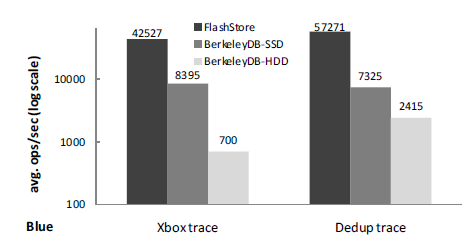Solid state storage have become increasingly popular since the introduction of SSD drives in retail. Even if Windows 7 and other operating systems have become better at handling flash storage units it is still far from perfect. Something two scientists at Microsoft has changed with its new technology FlashStore.
FlashStore acts like a flash-based data bridge between a conventional harddrive for storage and the regular RAM. The idea is to act as an efficient middle-hand for the super-fast RAM and the storage efficient mechanical drive. But FlashStore isn’t just a solution that improves the performance of regular RAM + harddrive systems, but also RAM + SSD systems will get better performance through the smarter data handling of FlashStore.
Sudipta Sengupta and Jin Li are the two Microsoft scientists that developed FlashStore and the idea is to optimize how software and applications use different storage media. Technology that today is in an early development stage, but may appear in future Windows operating systems.
FlashStore use different key values to keep track of the data that is written, read, updated and deleted. These key values can be used to speed up the storage of data on a harddrive by letting it pass through the much faster flash memory, which also makes it possible to optimize SSD performance.
Random writes of small files is often devastating for SSDs, not just because it lowers performance substantially (why 4K performance is often considered a good measuring point for SSDs) but also because it tears on the memory cells. A write of data to an SSD is made one “page” at a time (often only 4 Kilobyte), pages that is the base structure of all NAND flash cells. This means that data that is smaller than 4KB still requires 4KB to be written, which often results in unnecessary work and trashed memory cells with empty slots.
To minimize writes to the flash memory FlashStore sets aside a part of the RAM for storing data from smaller random writes. Not until the RAM has enough data to fill one or more pages with data the actuall data is sent to the SSD. The technology as a whole will almost eliminate random writes and isntead let the better suiting RAM handle this load. By making all writes to the SSD sequential it optimizes the speed of the flash memory.
The developers behind FlashStore claims the technology can improve performance of a regular RAM/harddrive environment 60 fold, while performance in a RAM/SSD environment (with a very powerful Fusion-IO PCIe SSD) can increase five fold, through a more efficient and smarter way of moving data between storage media. Something the scientists have confirmed on, among others, Microsoft’s Xbox platform.

Tests done on a C2D 8500E system with 80GB Fusion-IO SSD and 250GB Seagate Barracuda 7200RPM harddrive
FlashStore sounds like a very exciting technology for future operating systems and shows that SSD performance is sitll very dependent on operating system and software.
Source: StorageNewsletter


















